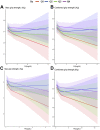Moderate selenium mitigates hand grip strength impairment associated with elevated blood cadmium and lead levels in middle-aged and elderly individuals: insights from NHANES 2011-2014
- PMID: 38161700
- PMCID: PMC10757617
- DOI: 10.3389/fphar.2023.1324583
Moderate selenium mitigates hand grip strength impairment associated with elevated blood cadmium and lead levels in middle-aged and elderly individuals: insights from NHANES 2011-2014
Abstract
Background: Selenium (Se) has been reported to have an antagonistic effect on heavy metals in animals. Nevertheless, there is a lack of epidemiological research examining whether Se can mitigate the adverse effects of cadmium (Cd) and lead (Pb) on hand grip strength (HGS) in middle-aged and elderly individuals. Methods: This study used data from the 2011-2014 National Health and Nutrition Examination Survey (NHANES). HGS measurements were conducted by trained examiners with a dynamometer. Concentrations of Se, Cd, and Pb in blood were determined via inductively coupled plasma mass spectrometry. We employed linear regression, restricted cubic splines, and quantile g-computation (qgcomp) to assess individual and combined associations between heavy metals and HGS. The study also explored the potential influence of Se on these associations. Results: In both individual metal and multi-metal models adjusted for confounders, general linear regression showed Se's positive association with HGS, while Cd and Pb inversely related to it. At varying Se-Cd and Se-Pb concentrations, high Se relative to low Se can attenuate Cd and Pb's HGS impact. An inverted U-shaped correlation exists between Se and both maximum and combined HGS, with Se's benefit plateauing beyond approximately 200 μg/L. Stratified analysis by Se quartiles reveals Cd and Pb's adverse HGS effects diminishing as Se levels increase. Qgcomp regression analysis detected Se alleviating HGS damage from combined Cd and Pb exposure. Subsequent subgroup analyses identified the sensitivity of women, the elderly, and those at risk of diabetes to HGS impairment caused by heavy metals, with moderate Se supplementation beneficial in mitigating this effect. In the population at risk for diabetes, the protective role of Se against heavy metal toxicity-induced HGS reduction is inhibited, suggesting that diabetic individuals should particularly avoid heavy metal-induced handgrip impairment. Conclusion: Blood Cd and Pb levels are negatively correlated with HGS. Se can mitigate this negative impact, but its effectiveness plateaus beyond 200 μg/L. Women, the elderly, and those at risk of diabetes are more vulnerable to HGS damage from heavy metals. While Se supplementation can help, its protective effect is limited in high diabetes risk groups.
Keywords: cadmium; hand grip strength; heavy metals; lead; selenium; toxicity.
Copyright © 2023 Liang, Wang, Wang, Li, Yin, Liu, Wei, Fan, Feng and Zhai.
Conflict of interest statement
The authors declare that the research was conducted in the absence of any commercial or financial relationships that could be construed as a potential conflict of interest.
Figures





Similar articles
-
Moderate selenium alleviates the pulmonary function impairment induced by cadmium and lead in adults: A population-based study.Sci Total Environ. 2023 Dec 10;903:166234. doi: 10.1016/j.scitotenv.2023.166234. Epub 2023 Aug 11. Sci Total Environ. 2023. PMID: 37572899
-
Associations among blood heavy metals, neurofilament light chains and cognition function in US adults: NHANES 2013-2014.Ecotoxicol Environ Saf. 2025 Jul 1;299:118369. doi: 10.1016/j.ecoenv.2025.118369. Epub 2025 May 23. Ecotoxicol Environ Saf. 2025. PMID: 40412247
-
Association between heavy metal exposures and the prevalence of pelvic inflammatory disease: a cross-sectional study from the National Health and Nutrition Examination Survey 2013-2018.Environ Sci Pollut Res Int. 2023 Nov;30(52):112433-112444. doi: 10.1007/s11356-023-30176-6. Epub 2023 Oct 13. Environ Sci Pollut Res Int. 2023. PMID: 37831240
-
Single and joint exposure of Pb, Cd, Hg, Se, Cu, and Zn were associated with cognitive function of older adults.Sci Rep. 2024 Nov 19;14(1):28567. doi: 10.1038/s41598-024-79720-5. Sci Rep. 2024. PMID: 39558028 Free PMC article.
-
Epidemiological Evidence on the Associations of Metal Exposure with Alzheimer's Disease and Related Dementias Among Elderly Women.J Clin Med. 2025 May 28;14(11):3776. doi: 10.3390/jcm14113776. J Clin Med. 2025. PMID: 40507537 Free PMC article. Review.
Cited by
-
The Association Between the Non-essential Metal Mixture and Handgrip Strength in Chinese Community-Dwelling Older Adults.Biol Trace Elem Res. 2025 Jun;203(6):2960-2973. doi: 10.1007/s12011-024-04389-w. Epub 2024 Sep 26. Biol Trace Elem Res. 2025. PMID: 39322923
-
Relationship between nocturia, depression, and cognitive function and the mediating effects of nutritional indexes in older adults: data from NHANES 2011-2014.Front Nutr. 2025 Jul 2;12:1533683. doi: 10.3389/fnut.2025.1533683. eCollection 2025. Front Nutr. 2025. PMID: 40672414 Free PMC article.
-
Relationship between hypothyroidism and chronic kidney disease: Results from the National Health and Nutrition Examination Survey 2007 to 2012 and Mendelian randomization study.Medicine (Baltimore). 2024 Dec 20;103(51):e40925. doi: 10.1097/MD.0000000000040925. Medicine (Baltimore). 2024. PMID: 39705485 Free PMC article.
-
The mediating role of inflammatory biomarkers in the association between serum copper and sarcopenia.Sci Rep. 2025 Jan 11;15(1):1673. doi: 10.1038/s41598-024-84011-0. Sci Rep. 2025. PMID: 39799188 Free PMC article.
-
Association of two novel systemic inflammatory biomarkers and frailty based on NHANES 2007-2018.Front Public Health. 2024 Apr 8;12:1377408. doi: 10.3389/fpubh.2024.1377408. eCollection 2024. Front Public Health. 2024. PMID: 38655524 Free PMC article.
References
LinkOut - more resources
Full Text Sources

